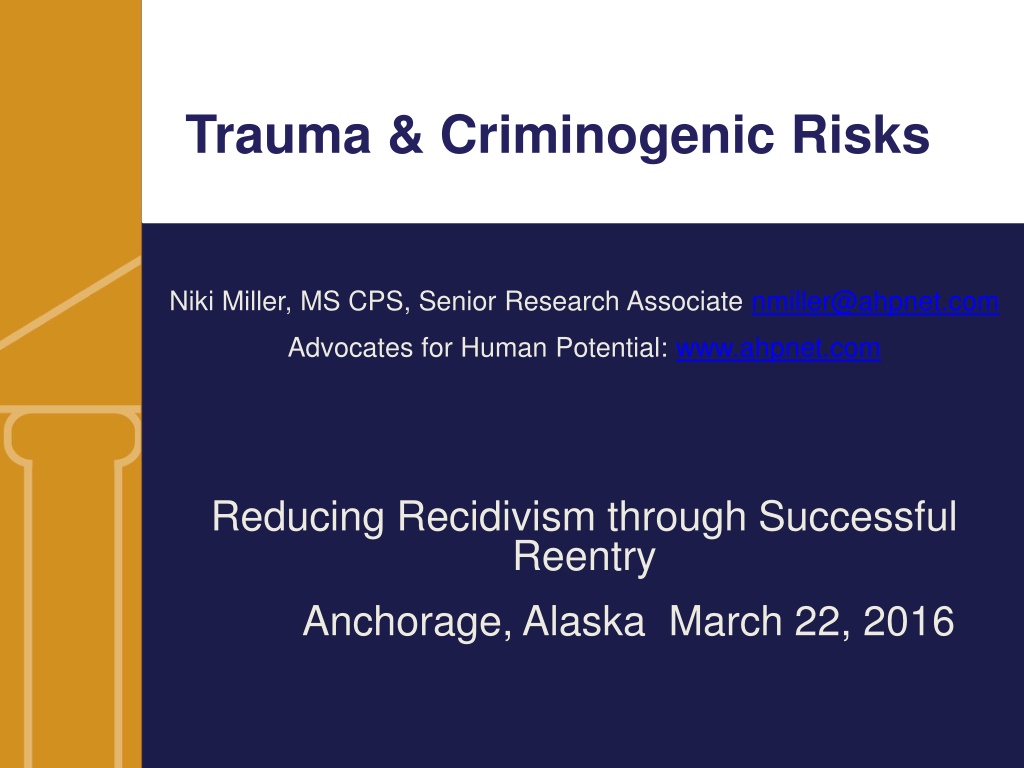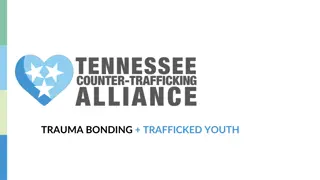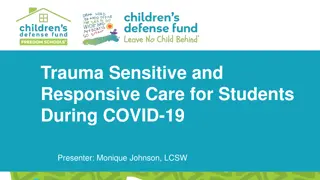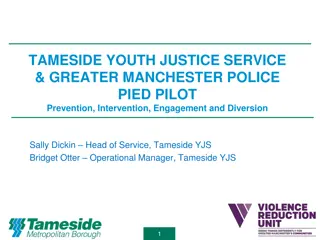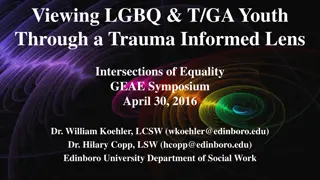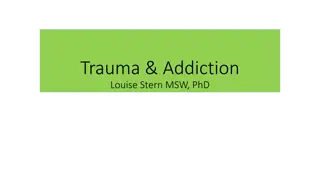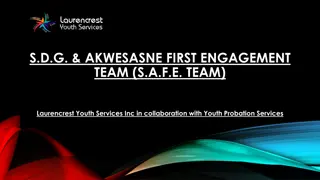Understanding Trauma and Criminogenic Risks in Justice-Involved Youth
Exploring the correlation between trauma and criminogenic risks in justice-involved youth, this content emphasizes the importance of trauma-informed approaches to prevent difficulties, enhance safety, and improve engagement in effective programs. Insights from implementation results and the significance of self-care and supervision in supporting participants are highlighted.
- Trauma-informed approaches
- Justice-involved youth
- Criminogenic risks
- Self-care
- Program implementation
Download Presentation

Please find below an Image/Link to download the presentation.
The content on the website is provided AS IS for your information and personal use only. It may not be sold, licensed, or shared on other websites without obtaining consent from the author. Download presentation by click this link. If you encounter any issues during the download, it is possible that the publisher has removed the file from their server.
E N D
Presentation Transcript
Trauma & Criminogenic Risks Niki Miller, MS CPS, Senior Research Associate nmiller@ahpnet.com Advocates for Human Potential: www.ahpnet.com Reducing Recidivism through Successful Reentry Anchorage, Alaska March 22, 2016
there are no sufficient literary, psychological, or historical answers to human tragedy, only moral ones. . Just as despair can come to one only from other human beings, hope, too, can be given to one only by other human beings. -Elie Wiesel Please take a moment to fill out the self care plan handout
Purpose Certain difficult, inexplicable, even dangerous behaviors justice involved youth exhibit may be related to past trauma. Not to excuse Not even to explain Applying trauma-informed approaches whenever possible can: Prevent or reduce difficulties Increase safety for staff and youth alike Lead to better engagement in effective programs 3
Success means participants begin to Trust their good instincts, based on what they know and may learn View self-care & supervision as essentials Try out some of the techniques & tools Share information about TI approaches Check out some of the resources 4
Results of Implementation Observations from justice professionals: When program staff know about trauma histories, youth are relieved not to have to keep repeating their story They have started to let staff know they need a respite, before behavior accelerates Noted fewer drug court clients were displaying resistance; view the court as a safe place Many reports of noticeable improvements in how well women do in treatment programs Jails and lock-ups: We send in a non-uniformed staff member to talk with some inmates that are having mental difficulties 5
What do we mean by Trauma? A state of extreme stress brought on by conditions, or by shocking, unexpected events, that overwhelm a person s capacity to cope resulting in feelings of helplessness, terror and violation. The individual s capacity to cope is so seriously overwhelmed that they experience complete powerlessness and loss of control An event may be witnessed or experienced as a threat to survival, or an intolerable violation of self or a loved one.
Traumatic Events & PTSD Percentage exposed who develop PTSD (Bloom, 2011) Rape 49.0% Severe beating 31.9% Other sexual assault 23.7% Serious accident or injury 16.8% Shooting or stabbing 15.4% Child's life-threatening illness 14.3% Sudden death of a close friend 10.4% Witness killing or serious injury 7.3% Natural disaster 3.8% 7
The Case for TIC as a Universal Precaution Universal strategies address entire groups that share the same general risk. Universal strategies are applied to groups without any prior screening, when the entire group is capable of benefiting. 9/16/2024 8
Astounding numbers TAPA Center for Jail Diversion Study Significant PTSD rates among death row inmates (Freedman & Hemenway, 2000) Violent offenders more likely to have PTSD than not (Carlson and Shafer, 2010). A diagnosis of PTSD not necessary to be severely affected 9
The impact on staff Empathic engagement with trauma survivors can result in changes that may parallel trauma responses: Intrusive or obsessive thoughts or difficult emotions Feeling over-responsible; overworking Physical health problems Feelings of distrust or excessive concern for loved ones Loss of hope or a diminished sense of control over one s fate Over-identification or disconnectedness, callousness and anger are common. 10
Self-Care Exercise Sample Self-Care Plan: If I become exhausted, emotional, numb or angry: I can talk to __________ about my feelings. I can take a break. I can stretch or exercise or go for a walk. I can eat something nutritious. I can eat something not so nutritious (chocolate!) I can think of some of the successful clients I have helped. I can take a nap or lie down. I can watch something funny or entertaining. I can play with my pet or my children. I can shoot baskets or play another sport. 11
Self-Care: Model it, live it and teach it! Take breaks or rotate job duties Make time for supervision Find meaning Support from co-workers and outside support ESCAPE! REST! FUN! For an excellent free online course on preventing secondary trauma from the Headington Institute visit: http://www.headington-institute.org/ 12
Adverse Childhood Experience Study Questions Asked about Abuse & Household Dysfunction ( n = 17, 421) Types of abuse (by category) Sexual (by anyone) 22% Psychological (by parents) 11% Physical (by parents) 11% Types of household dysfunction (by category) Substance abuse 26% Mental illness 19% Mother treated violently 13% Imprisoned household mother 3% 13
ACE effects on women and substances: Women with 4 or more types of childhood trauma had a 78% attributable risk for IV drug use. Women who did not experience any of these instances had a .05% attributable risk for IV drug use. Women with histories of childhood sexual abuse were 60% more likely to abuse alcohol and 70% more likely to use illegal drugs. They were also most likely to experience further abuse. 14
ACE effects-men: addiction & alcoholism A male child who experienced at least 6 types of adverse childhood experiences was 4,600% more likely to become an IV drug user Self-acknowledged alcoholism in men and women increased 500% in relation to adverse childhood experiences. 15
Please fill out the ACE exercises in small groups Is intravenous drug use properly viewed as a personal solution to problems that are well concealed by social niceties and taboo? Is drug abuse self-destructive or is it a desperate attempt at self- healing the best coping device that an individual can find? ~Vincent Feletti, MD ACE Study
ACE events data for youth referred to Massachusetts Juvenile Court Clinics Original CDC Study Sample Median Score: 1 Proportion scoring 4+ 6.2 % MA. Juvenile Justice Sample Median Score: 5 Proportion scoring 4+ 63 % Source: Massachusetts Alliance of Juvenile Court Clinics data report 2013 17
Trauma, cognitive development and health Impact of chronic hyper-arousal: Can affect the architecture, development, and functioning of the brain. Chronic exposure to stress hormones increases the risk of health problems. Profound impact on belief system. 18
The body responds to the brains signals When a threat is perceived Heart rate and respiration increase, preparing the body for a survival response. Blood flows out of the thinking centers of the brain and into the limbs to get them ready to run. Pupils dilate for better night vision; hearing is sharpened. Pain and hunger are temporarily dulled. 19
Effects of trauma memory can make the present more painful than the past There is evidence that trauma is stored in the part of the brain called the limbic system, which processes emotions and sensations, but not language or speech. For this reason, people who have been traumatized may live with implicit memories of terror, anger, and sadness generated by the trauma, but with few or no explicit memories to explain the feelings. Sidran Traumatic Stress Foundation 21
Harriet When I was on probation I had to go to a substance abuse group with a bunch of other kids. Every week I dreaded it. I never said anything, skipped as many as I could, and got high afterward. The counselor s report said I was treatment resistant and refused to participate. I never knew why I hated it so much until I learned to identify my triggers. There was only one other girl and about six guys. Most of them wore leather jackets. It was the smell of leather that I couldn t stand. When I was 15, I cut school and took off with a group of bikers to party. To make a long story short, they raped me in a field near my school. I just can t stand to be around the smell of leather.
Our brains are sculpted by our early experiences. Trauma is a chisel that shapes a brain to contend with strife, but at the cost of deep, enduring wounds. Teicher, 2000
Trauma & Criminogenic Needs Trauma Sequelae Self- Medication/ Addiction Behavioral Effects (Begin Anywhere) Victimization Vulnerability Juvenile Justice- involvement 24
Managing Responses Source: C. Amrhein, Bronx TASC -Mental Health Court Program-ON THE FRONT LINES: BUILDING SKILLS FOR REENTRY & DIVERSION Affective Violence Predatory Violence Intense physiological arousal Minimal physiological arousal Subjective experience of emotion No awareness of emotion Reactive & immediate Planned & purposeful Internal or external perceived threat No imminent or perceived threat Time-limited sequence of behaviors No time-limited sequence Possible displacement of target No displacement of target Heightened but diffuse awareness Heightened & focused awareness Primarily emotional & defensive Primarily cognitive Goal is threat reduction Violent behavior is planned
Antisocial Personality Traits & Associates Emotional numbing can predispose survivors to thrill-seeking behavior, disregard for their own safety, difficulty empathizing with others, and can support criminal thinking. Distrust of authority figures and of institutions; gravitate to others with similar beliefs; strong feelings about retribution and justice. 26
Trauma and Antisocial Attitudes Every summer my mom made me go to church camp. One of the brothers used to come into our bunks at night and do things to us. I didn t know he was doing it to other boys, so I kept it secret because I thought it was just something about me that made him do it. I decided there was no reason to play by the rules when nobody else did. The summer I turned 14, I broke into the camp office, took the cash and whatever else I could find and ran. I don t think I ever stopped . 27
Foundations of Trauma-Informed Care Trauma informed approaches: All staff understands trauma & its impact on the addiction and mental health recovery process and on rehabilitation Services are designed to enhance safety, minimize triggers, and prevent re-traumatization Staff and clients relationships are based on power sharing and healing; survivors are empowered with info, referrals, and hope. Trauma specific services Clinical and program staff have specialized training in integrating trauma treatment and recovery practices. Specific groups and effective interventions are aimed at coping with the aftermath of trauma, decreasing symptoms of trauma-related disorders and increasing knowledge about trauma. People are empowered to manage the ongoing effects of exposure to violence & trauma. 9/16/2024 28
Justice-involved females & males Females Childhood sexual abuse PTSD after exposure more likely - 20% Males Witness to a killing or serious assault Exposure more likely, PTSD less 8% May prefer to use other drugs More likely to use alcohol in response Sexual/violent victimization from intimates sometimes report feeling be safer in custody Violence from strangers; sexual abuse in community triggered by threat of violence in custody Most common additional diagnosis is depression; not as common as in women More likely to have complex PTSD and accompanying depression Internalize - eating disorders, addiction, cutting Likely to be treated through mental health Externalize-alcohol, hyper-arousal, thrill seeking, defensive violence Treated through substance abuse systems Treatment emphasizes empowerment, emotion regulation and safety Treatment emphasizes identifying feelings, relationships and empathy (Miller and Najavits, 2011)
What is Post-traumatic Stress Disorder ? An anxiety disorder people can develop after seeing or living through a terrifying event, extreme abuse, or exposure violence and other horrendous conditions Most people exposed to danger and violence do not develop PTSD; they are affected, but only temporarily. Acute Stress Disorder: after a stressful event a serious automobile accident, for example for about a month. 31
Risk factors increase the likelihood of serious problems Before Past abuse/victimization beginning in childhood Few resources or supports; social isolation Seeing others hurt or killed or being injured Prolonged or repeated abuse; multiple types During Being cut off from support; stigma Added stress such as loss of home After 32
PTSD: 3 major symptom types; plus added diagnostic criteria Avoidance Intrusion Arousal Negative changes in thinking and mood Flashbacks Nightmares Startle reflex Suppression of memories Irritability Changes in arousal and reactivity Restriction of daily activities Hyper-vigilance Re-enactment Sleep disturbance Substance use 33
Resilience factors reduce the risk of lasting harm Protecting others during the event Feeling good about acting despite the danger Finding a way of coping and getting through During Having support from friends, family or a group Finding a way to make meaning or learn from the experience After 34
Trauma-Informed Principles 1. Trauma recovery encompasses multiple aspects of peoples lives, involves changing deep beliefs and gaining knowledge and skills. 2. The assumption of a trauma history guides every encounter, whether or not the participants disclose or even remember trauma. 3. Responses are reframed as survival strategies that served a safety function and are seen as evidence of strength and resiliency. 4. Creating safety is a primary task: the safer and more predictable the environment, the better the engagement. 5. Education and information about trauma is part of treatment. 6. Power sharing is the basis of helping relationships that are founded on respect, information, connection, and hope. 35
Trauma-informed approaches Screening and referral Integrated treatments Universal measures Applied when a group shares the same general risk Applied without prior screening when the entire group can benefit Interventions that target more than one issue; trauma & substance use Screens can ask about event history, current functioning or current safety Cognitive-behavioral groups may help with both; can benefit clients w/depression or other mental health issues How does screening benefit inmates; who should screen and when? Universal measures: are harmless to those without trauma. What can or cannot become part of SOPs? Some also address criminal thinking 36
Implementation Basics Preliminary goals: increase safety and do no harm Guidelines re: trauma screening in correctional settings Basic stabilizing skills and responses; dealing with triggers Integrate evidence-based treatments appropriate to correctional settings Supervision, training and support for staff 37
Trauma Screening Guidelines Explain the screening in advance, how the information will be used to benefit the client. Let the client know that yes or no answers are fine unless he or she wishes to say more. Use valid screening tools that focus on present-day symptoms (ex: Trauma Symptom Checklist) If screening for specific types of past trauma, use a checklist the client can read and mark off rather than asking about past abuse during an interview. Give the client as much control as possible, including time and location, passing on questions and taking breaks. Be aware of your own nonverbal responses during the interview. If the clients become upset or agitated redirect them by asking about strengths, the people and things that helped them get through how these events affect them today and what works to help feel better. 9/16/2024 38
Trauma Stabilization Skills Grounding - directs attention to the here-and-now and uses the senses as an anchor to the present When the CO told me to pick up the mop, my fists were clenched and I could feel myself starting to get crazy. I could feel something pounding up through my chest and in my throat . I began grounding. I counted the trees that lined the fence perimeter outside. Then I counted how many colors were on each tree. I forgot why I was so pissed off and picked up the mop. 9/16/2024 39
Self-Care Self-care is learning to self-monitor emotional states, to evaluate choices and actions, and actively pursue emotional, mental, and physical healing. I decided that I am not going to watch movies that have violence or rape scenes. I was watching Law and Order Special Victim s Unit every week. I noticed I couldn t sleep on those nights, and I felt depressed. I like the show, but right now I am not going to watch it. 40
Strength-Based Build self-efficacy by pointing out success, reinforcing the ability to change and to assert control over thinking and behavior. I never thought I could control myself when someone got in my face like that. But, you re right, I did it for years around my stepfather. Even when I was 8 or 9 years old, I wanted to kill him every time he hit my mom. But, I had to control myself, and I guess the practice I got is helping now that I m sober. 41
Self-Soothing Self-soothing prepares and teaches comforting and calming procedures before or after a triggered response: I made the list to share in group of things that make me feel good: my dog; riding my motorcycle; fishing; shopping for fishing rods and tackle and eating outside. The best thing for staff to do when I am agitated is to remind of how my dog looks when he runs free in the woods. 42
Identifying & Coping with Triggers Advanced directives - work with youth to answer: What kinds of reminders are difficult to deal with? What helps you calm down when you are triggered? What are the things staff can do to help when you are reacting to a trigger? 9/16/2024 43
Giving voice to survivors The more proactive we become by asking what helps and what makes things worse in times of crises, the greater opportunity we have to align with clients in their healing. - Laura Prescott 44
PEACE: An approach to avoidable triggers Predict and prepare: When you go before the parole board a whole panel of people will be deciding your future. Tell me what steps you can take to feel calmer. How about afterward? Enlist: What has helped you in the past not to drink when you had to deal with your mother yelling at your kids? 45
Acknowledge: Many people have difficulty sleeping in early recovery. I can understand why being it here makes it more difficult. I d probably have a hard time sleeping myself. Choice and control: We ask each person to provide a urine sample. Would you like to go take care of it now, or would you rather let me know when you are ready? Explain: We have to put everyone through the metal detector, even attorneys. We can make sure no weapons are in the building. It makes everyone safer. (Miller, 2010) 46
Sanctions and Rewards Research on sanctions tells us incentives are more effective at shaping behavior. BJA recommends incentives/rewards outnumber sanctions. Components of effective sanctions: certainty; speed; graduated - progressively more intense; and drug court clients understand the result of each violation or achievement. But, some sanctions can remind survivors of past punitive abuse, and this can derail their effectiveness. Rewards and sanctions, developed with trauma in mind Observe how clients respond to sanctions Increase the role of incentives. 47
PERCEPTION TRIAD Non-intervening witness Abuser Enlightened witness Rescuer Victim 48 (N.Miller, 2008)
RICH: Respect and Information This model states these elements form the basis for all trauma-informed communication: Respect: This may be a very different response than expected. It can be challenging to convey respect consistently. Clients may view staff and authority through the lens of past abuse from neglectful mothers and abusive fathers. Information: Let clients know what is going to happen and why. Provide education on the relationship between trauma and substance use and how others have successfully overcome the effects of trauma. 49
RICH: Connection and Hope Connection: With the here-and-now and connections with people, as well as internal connections; between the mind, body and spirit, between actions and values. Safe connections with others re-write the patterns of abuse within relationships and ground survivors in today. Hope: Remind clients that they have many strengths, have survived many things. Recount their recent successes, small victories and strengths. The successes of others in recovery helps sustain hope for staff and clients alike. 50
